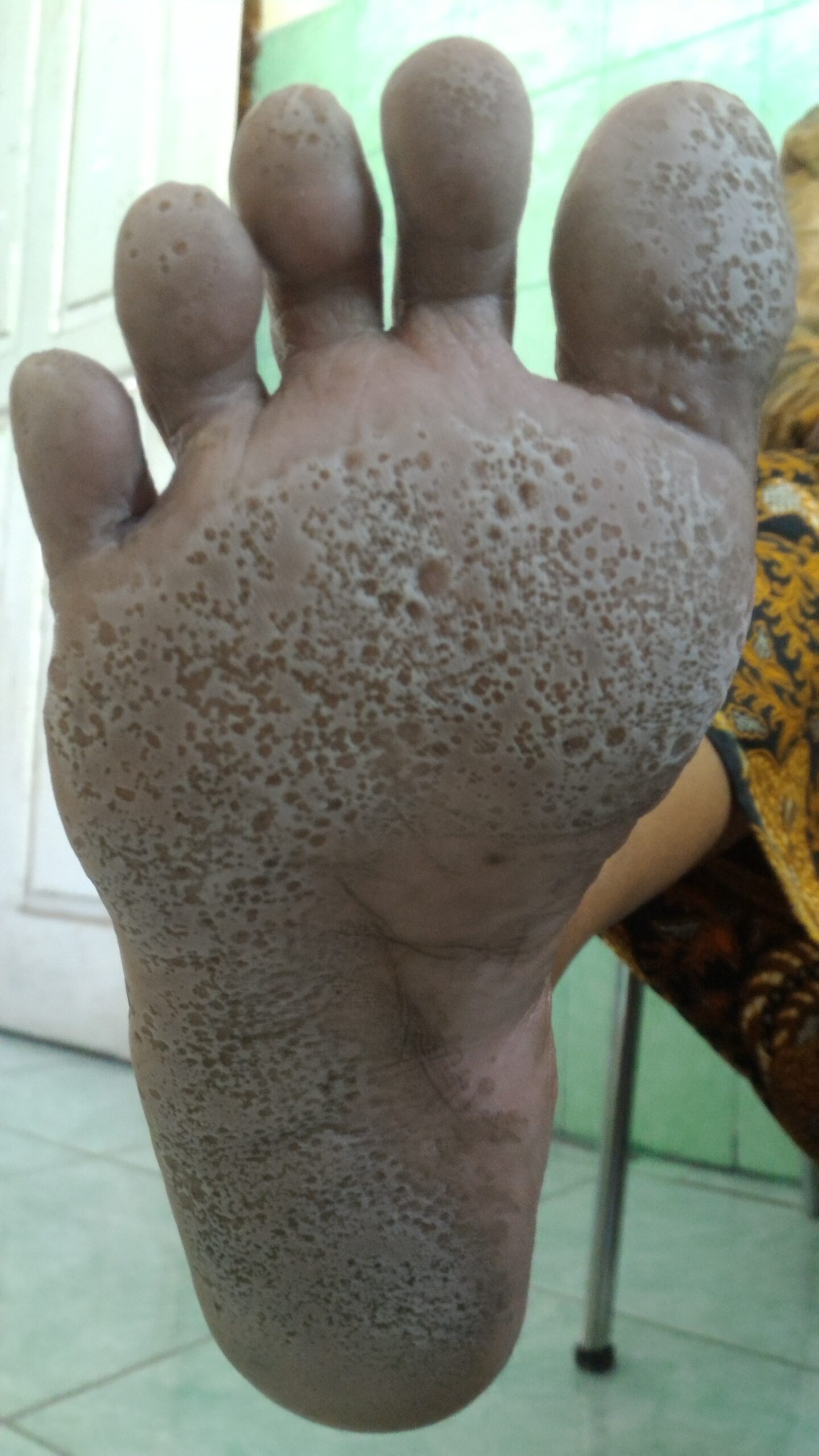What are the symptoms of pitted keratolysis?
Pitted keratolysis is a skin condition affecting the soles of the feet and, less commonly, the palms. Here are the key symptoms:
- Pitted Lesions: The primary symptom is the presence of small, shallow, crater-like pits or depressions in the skin, primarily on the weight-bearing areas of the soles. These pits can vary in size and depth.
- Odor: An unpleasant, foul odor is often associated with the condition. This is due to the bacterial infection that contributes to the development of the pits.
- Skin Discoloration: The affected skin may appear lighter or darker than the surrounding areas.
- Hyperhidrosis: Excessive sweating (hyperhidrosis) of the feet, which can contribute to the development and persistence of the condition.
- Mild Itching or Irritation: Some individuals may experience mild itching or irritation in the affected areas.
- Peeling or Scaling: In some cases, the skin around the pits may peel or scale.
Pitted keratolysis is often associated with warm, moist environments and poor foot hygiene. It’s important to consult a healthcare provider for an accurate diagnosis and appropriate treatment, which typically includes topical antibiotics or antifungal medications to address the underlying bacterial infection and improve foot hygiene.
What are the causes of pitted keratolysis?
Pitted keratolysis is primarily caused by bacterial infections, often associated with certain environmental and behavioral factors. Here are the main causes and contributing factors:
- Bacterial Infection: The condition is commonly caused by bacteria, including Klebsiella species, Corynebacterium species, and Micrococcus species. These bacteria thrive in moist, warm environments and are responsible for the formation of the characteristic pits.
- Excessive Sweating: Hyperhidrosis, or excessive sweating of the feet, creates a moist environment that promotes bacterial growth and infection, which can lead to pitted keratolysis.
- Poor Foot Hygiene: Inadequate foot hygiene, such as infrequent washing or failure to dry the feet properly after washing, can contribute to the development of the condition.
- Wearing Non-Breathable Footwear: Shoes that do not allow proper ventilation and are made of non-breathable materials can trap moisture and heat, creating an ideal environment for bacterial growth.
- Prolonged Moisture Exposure: Extended exposure to moisture, such as from prolonged wearing of damp socks or working in wet environments, can increase the risk of developing pitted keratolysis.
- Warm and Humid Environments: Environments that are consistently warm and humid can exacerbate the condition by promoting bacterial growth on the feet.
- Compromised Immune System: A weakened immune system can make individuals more susceptible to infections, including those that cause pitted keratolysis.
Addressing these underlying causes through improved hygiene practices, appropriate footwear, and treatment of bacterial infections can help manage and prevent pitted keratolysis.
How is the diagnosis of pitted keratolysis made?
The diagnosis of pitted keratolysis is typically made through a combination of clinical evaluation and laboratory tests. Here’s an overview of the diagnostic process:
- Clinical Evaluation:
- History and Symptoms: A healthcare provider will take a detailed history and inquire about symptoms such as foot odor, the presence of pits or depressions on the soles of the feet, and any associated discomfort or itching.
- Physical Examination: The provider will examine the affected area, typically the soles of the feet, for characteristic signs of pitted keratolysis. The condition is often identified by the presence of small, shallow pits or depressions in the skin, along with possible odor and peeling.
- Microbiological Testing:
- Swab Culture: A sample of the affected skin is taken using a swab and sent to a laboratory for culture. This helps identify the specific bacteria causing the infection. Common bacteria involved in pitted keratolysis include Klebsiella species, Corynebacterium species, and Micrococcus species.
- Microscopy: The laboratory may also use microscopy to examine the sample for characteristic bacterial colonies or other signs of infection.
- Dermatological Assessment:
- Dermatoscopy: In some cases, a dermatoscope may be used to visualize the skin lesions more clearly and differentiate pitted keratolysis from other similar conditions.
- Exclusion of Other Conditions:
- Differential Diagnosis: The healthcare provider will consider other possible conditions that may present with similar symptoms, such as fungal infections (e.g., athlete’s foot), eczema, or psoriasis. This is important to ensure an accurate diagnosis and appropriate treatment.
A definitive diagnosis is made based on the combination of clinical findings and microbiological results. Proper identification of the causative bacteria can guide effective treatment.
What is the treatment for pitted keratolysis?
Pitted keratolysis is a bacterial skin infection that affects the soles of the feet, and sometimes the palms, leading to small, shallow pits in the skin. It is often associated with excessive sweating and a foul odor. The treatment focuses on addressing the bacterial infection, controlling sweating, and improving hygiene.
Treatment for Pitted Keratolysis:
- Topical Antibiotics: The primary treatment for pitted keratolysis is the application of topical antibiotics to kill the bacteria causing the infection. Common antibiotics used include:
- Clindamycin
- Erythromycin
- Mupirocin
- Fusidic acid
- Antibacterial Soaps: Regular use of antibacterial soap helps to reduce bacterial load and prevent reinfection.
- Antiperspirants: To control excessive sweating (hyperhidrosis), aluminum chloride-based antiperspirants can be applied to the affected areas. Reducing moisture can help prevent the growth of bacteria.
- Oral Antibiotics: In severe or recurrent cases, doctors may prescribe oral antibiotics if topical treatments are insufficient.
- Foot Hygiene: Improving foot hygiene is crucial. This includes:
- Keeping feet dry and clean
- Changing socks frequently
- Wearing breathable shoes to reduce moisture buildup
- Using foot powders or moisture-wicking socks to keep feet dry
- Shoe Disinfection: Disinfecting footwear with antifungal or antibacterial sprays can help prevent re-infection.
In most cases, with proper treatment and hygiene, pitted keratolysis resolves within a few weeks.

Leave a Reply
You must be logged in to post a comment.